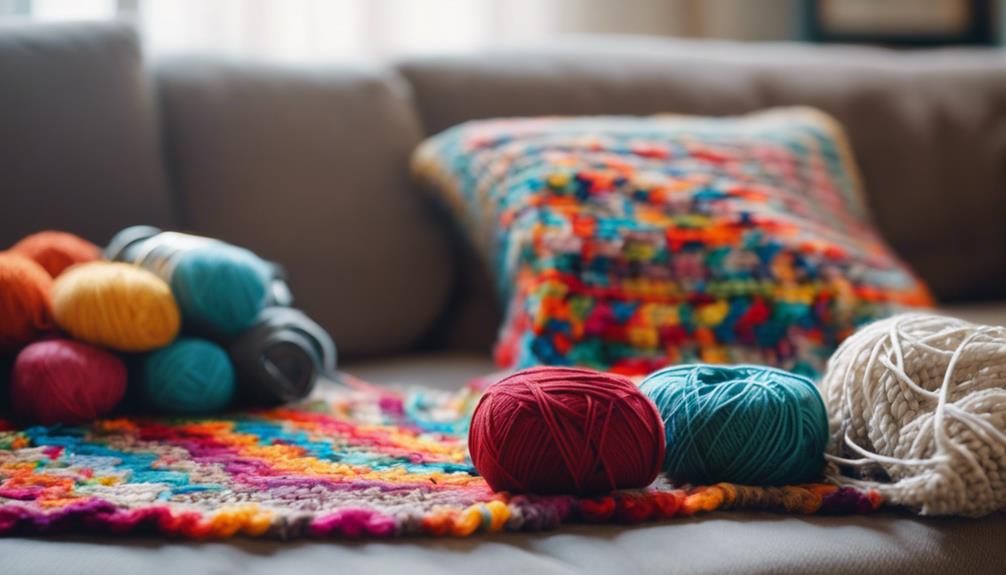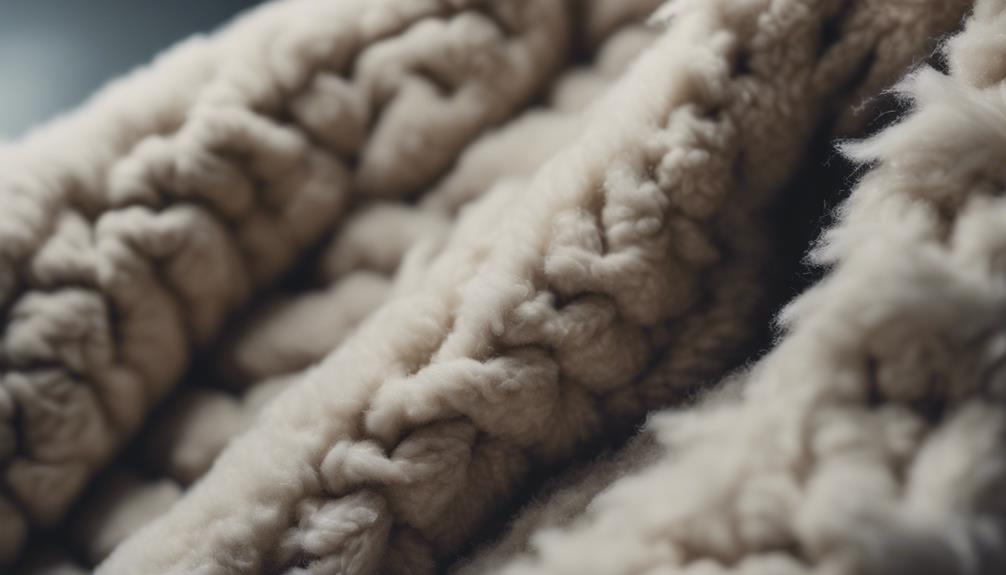When working on crochet projects, completion times can vary depending on factors such as size, complexity, and skill level. For example, approximately 65% of people finish a baby blanket within a month. Factors like pattern intricacy, yarn weight, and individual speed all play a role. Experienced crocheters are able to tackle more complex patterns efficiently, with practice improving their speed. To speed up completion time, it’s important to break projects into smaller parts and maintain consistent practice. Understanding these factors can help you plan and carry out projects effectively, ensuring steady progress. For more tips on increasing your crocheting speed and completing projects, explore further.
Key Takeaways
- Project size and complexity impact completion time significantly.
- Crocheter's skill level and experience influence efficiency.
- Yarn weight and hook size affect project speed.
- Consistent practice and time management expedite completion.
- Breaking projects into smaller parts enhances manageability and progress.
Factors Affecting Crochet Project Time

Factors impact the time required to complete a crochet project, including the project's size, pattern complexity, and the crocheter's skill level. When it comes to crochet, time is influenced by various elements.
The size of the project plays a significant role; larger projects naturally take more time to complete than smaller ones. For instance, a baby blanket will generally require more hours compared to a small amigurumi.
Additionally, the complexity of the pattern also affects the time investment. Elaborate patterns with intricate stitches or color changes will extend the duration needed to finish the project.
Another important factor is the crocheter's experience level. Those with advanced skills tend to work more efficiently and can navigate through patterns with greater ease, ultimately reducing the time needed to complete a project. Conversely, beginners may spend additional time understanding the instructions and perfecting their technique, leading to a longer completion period.
Time in crochet is a dynamic interplay between project size, pattern complexity, and the crocheter's experience level.
Average Time for Baby Blanket
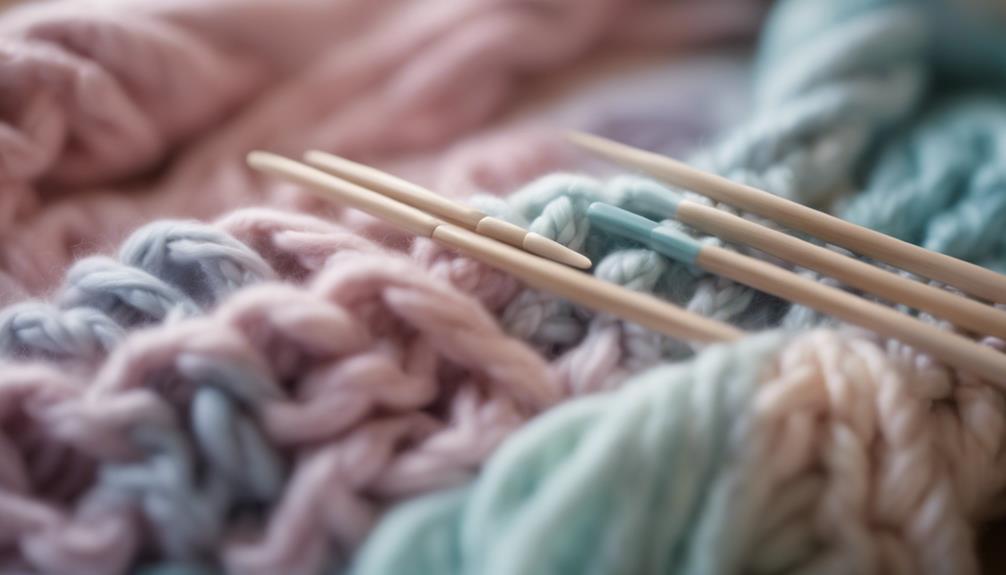
When crocheting a baby blanket, factors such as the blanket size, yarn choice, and stitch preferences play a vital role in determining the time it takes to complete the project. Understanding these elements can help crocheters estimate how long it might take to finish a baby blanket.
Baby Blanket Size
Completing a baby blanket typically takes an average of about one month for the majority of crocheters. When it comes to the time it takes to crochet a baby blanket, here are some key statistics to take into account:
- 65% of crocheters finish a baby blanket within 1 month.
- 21.4% of crocheters complete a baby blanket within 3 months.
- Only 4% take more than 6 months to finish a baby blanket.
These numbers indicate that the majority of crocheters can complete a baby blanket in a reasonable amount of time, usually within a month. Whether you're a beginner or an experienced crocheter, dedicating some time each day can help you finish your baby blanket project in a timely manner.
Yarn and Stitch Preferences
Our yarn and stitch preferences greatly influence the average time it takes to complete a baby blanket project. Choosing a thicker yarn and simpler stitches can markedly reduce the time needed for crocheting.
A longer stitch, such as double crochet, covers more space in each row, while intricate stitches like popcorn or cable may take longer to complete. The type of yarn used also impacts the speed of progress; bulky yarn works up faster than finer yarn due to its thickness.
Crocheting consistently for a few hours per day can expedite the process, shortening the completion time. By considering these factors and opting for yarn and stitches that align with your desired pace, you can effectively manage how long it takes to finish a baby blanket project.
Timeframe for Adult-Sized Afghans
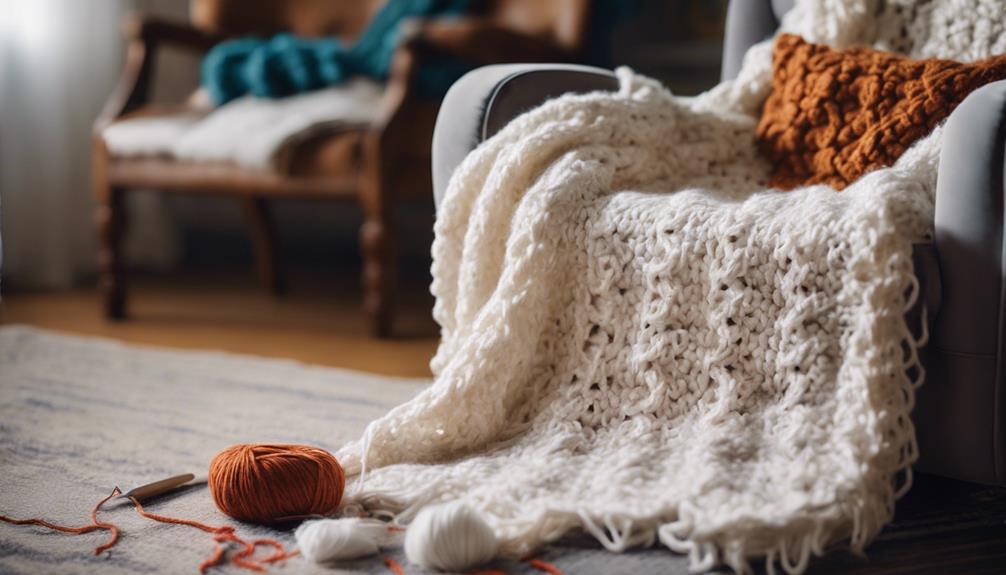
When considering the timeframe for adult-sized afghans, several key points come into play. Factors such as the chosen afghan stitch techniques, yarn selection tips, and various project completion factors greatly impact the overall time commitment required for these larger blankets.
Understanding how these elements interact can help crocheters estimate the completion time accurately for their adult-sized afghan projects.
Afghan Stitch Techniques
Crocheting adult-sized afghans requires varying time commitments depending on the chosen size, influenced by factors such as the number of stitches, yarn weight, hook size, and color choices. When considering the timeframe for completing an adult-sized afghan, it's vital to take into account the following:
- Blanket Size: Larger sizes like Queen or King will require more crocheting time compared to smaller sizes such as Twin due to the increased number of stitches and rows needed.
- Personal Crocheting Speed: Your individual pace can greatly impact the length of time it takes to finish an adult-sized afghan. Crocheting a sample swatch can help estimate your completion time based on your speed.
- Yarn Weight and Hook Size: Choosing heavier yarn weights and larger hook sizes can expedite the crocheting process, potentially reducing the overall completion time.
Yarn Selection Tips
Choosing a thicker yarn weight for adult-sized afghans can greatly decrease the time needed to finish the project. By using a larger crochet hook size with this yarn weight, the crocheting process is further expedited.
Opting for variegated or self-striping yarns eliminates the need for frequent color changes, saving time and effort. Pre-wound yarn cakes or skeins with longer yardage reduce interruptions for yarn changes and weaving in ends, streamlining the crocheting process.
Additionally, selecting a simple stitch pattern over intricate designs speeds up the project completion. These yarn selection tips play an important role in determining the time it takes to crochet an adult-sized afghan efficiently.
Project Completion Factors
Completing an adult-sized afghan can vary in time, influenced by factors such as the blanket's size, yarn weight, pattern complexity, and the crocheter's skill level. When it comes to afghans, the timeframe can be greatly impacted by these key elements:
- Size Matters: Larger afghans demand more time compared to smaller ones due to the increased number of stitches required.
- Yarn Weight Influence: Thicker yarns can lead to faster completion times as they cover more surface area per stitch.
- Skill Level Speed: Experienced crocheters often finish projects more quickly than beginners, who may take much longer to complete the same afghan.
Impact of Yarn Weight on Speed

When working on crochet projects, the yarn weight selected greatly influences the speed at which the project progresses. Lighter weight yarns like lace and fingering allow for quicker work due to their smaller stitches and thinner texture. On the other hand, bulky and super bulky yarns result in faster projects as they require larger stitches and fewer rows. Yarn weight directly impacts the overall size and thickness of the project, which consequently affects the completion time. Crocheting with different yarn weights offers versatility regarding project speed and texture, providing options for various desired outcomes.
| Yarn Weight | Speed of Project | Characteristics |
|---|---|---|
| Lace | Fast | Small stitches, thin texture |
| Fingering | Quick | Small stitches, thin texture |
| Bulky | Swift | Large stitches, fewer rows |
| Super Bulky | Rapid | Very large stitches, minimal rows needed |
Pattern Complexity and Time Investment
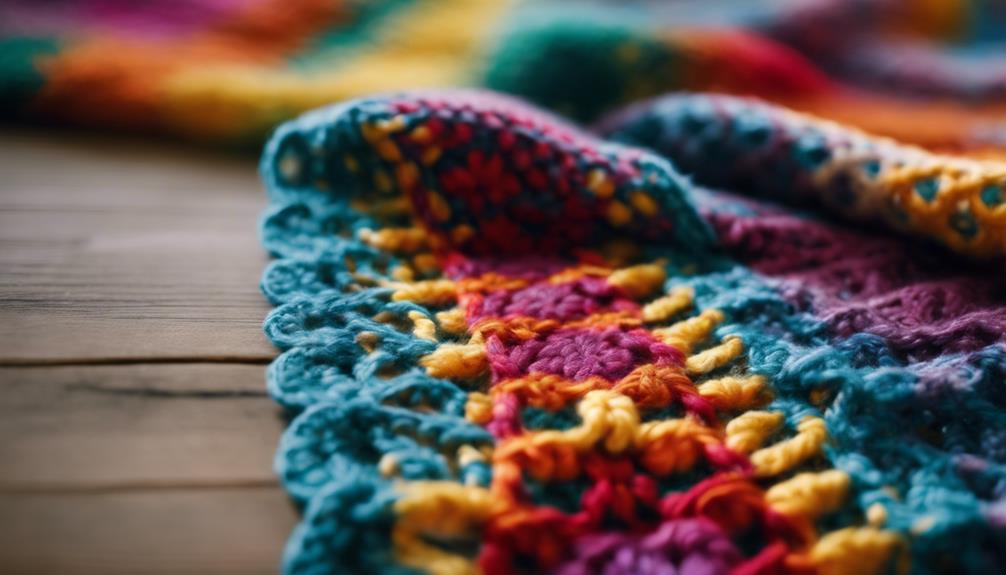
Exploring intricate crochet patterns demands a significant time commitment for completion. When diving into complex designs, one must be prepared to invest a substantial number of hours to finish the project. Here are three key points to contemplate regarding pattern complexity and time investment:
- Crochet Patterns: The intricacy of the pattern plays a crucial role in determining the time required to complete a project. Patterns that involve elaborate stitches, detailed motifs, and complex shaping demand more time and attention from the crocheter.
- Hours a Day: Completing a complex crochet project often involves dedicating several hours a day to work on it consistently. This regularity helps maintain momentum and ensures steady progress towards the final goal.
- Number of Hours: Unlike simpler designs that can be finished relatively quickly, intricate patterns may take a substantial number of hours to complete. Projects with multiple parts, intricate details, and small accessories can significantly increase the total time needed to finish.
Considering these factors when selecting a crochet pattern can help manage expectations and plan your time effectively.
Crocheter's Skill Level Influence
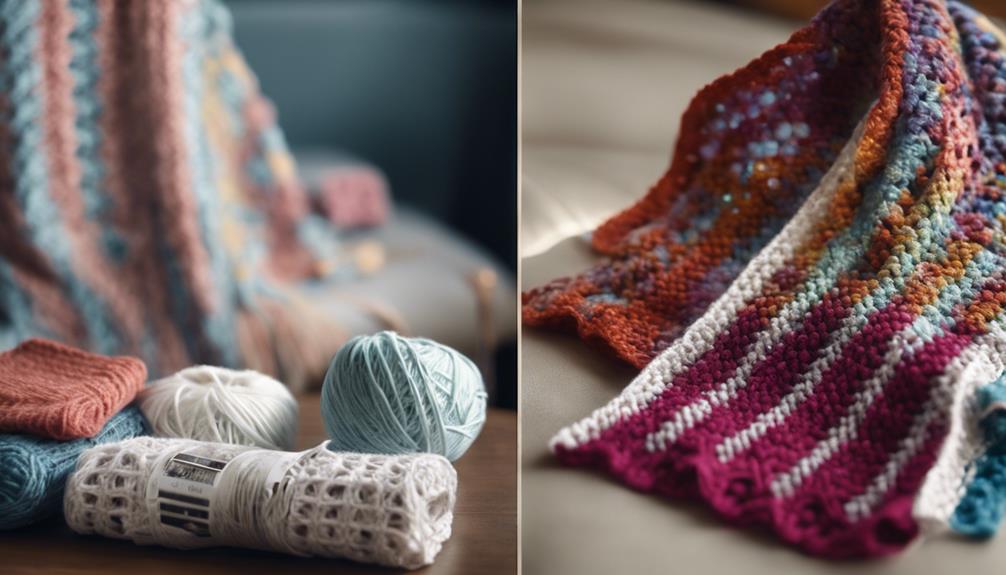
Proficiency in crochet techniques and pattern understanding greatly influences the speed at which advanced crocheters finish their projects. Advanced crocheters, with their in-depth knowledge and honed skills in crocheting, can navigate through complex patterns more efficiently. This expertise allows them to work at a faster pace, translating their vision into stitches with precision and speed.
Studies have shown that advanced crocheters complete projects in considerably less time compared to beginners or intermediate crocheters. Their familiarity with various stitches, techniques, and patterns enables them to tackle challenges swiftly, resulting in quicker project completion. The time taken to finish a crochet project decreases as crocheters advance in skill level, showcasing the direct correlation between expertise in crocheting and efficiency in completing tasks.
This proficiency not only enhances the quality of the finished piece but also demonstrates the benefits of continuous practice and skill development in expediting project timelines.
Strategies to Enhance Crocheting Speed

To boost crocheting speed, incorporating time-saving techniques and efficient project management strategies is key. Here are three strategies to enhance crocheting speed:
- Regular Practice: Like any skill, the more you practice, the faster you'll become. Dedicate regular time to crochet, even if it's just a few minutes each day. This consistency helps build muscle memory and familiarity with different stitches, ultimately speeding up your project completion time.
- Prepare in Advance: Before starting a project, gather all necessary materials and tools. Preparing everything in advance, like having yarn wound into balls, hooks organized, and stitch markers at the ready, eliminates interruptions during crocheting sessions and allows you to focus solely on stitching.
- Break Down Projects: Instead of tackling a project all at once, break it down into smaller parts. Allocate specific time slots each day to work on these sections. By dividing the project into manageable chunks, you can stay organized, motivated, and maintain a steady pace towards completion.
Project Completion Time Optimization
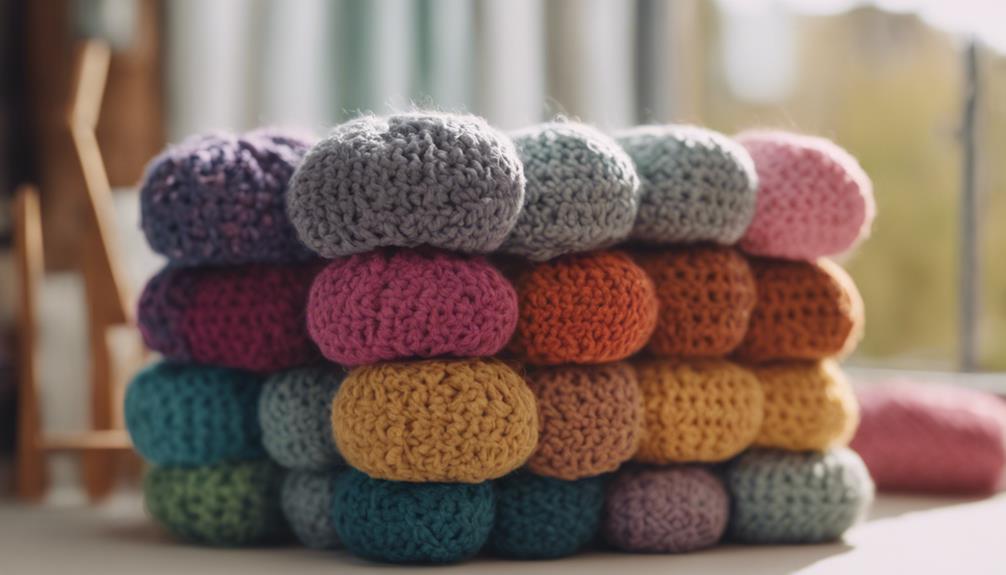
To optimize project completion time, applying efficient crocheting strategies and time-saving techniques is imperative. When tackling crochet projects, breaking them into smaller parts can make them more manageable. By setting aside dedicated daily crochet time, we can steadily progress towards completion.
Estimating how long a project will take based on the number of working hours available can help plan effectively. Preparing materials in advance, practicing new techniques early on, and double-checking stitch counts can prevent costly mistakes and save time in the long run.
Factors like crocheting speed, experience level, pattern complexity, and the size of the project all play a role in determining how long it takes to finish a crochet creation. By implementing these strategies and tips, we can enhance our efficiency and be able to finish our projects in a timely manner, ensuring a satisfying and rewarding crocheting experience.
Frequently Asked Questions
Does Crochet Take a Long Time?
Crocheting duration varies depending on project size and complexity. It's important to take into account factors like stitch count, assembly, and embellishments.
Breaking down tasks, setting daily goals, and adjusting pace can help manage completion time effectively. Preparation, stitch markers, and avoiding counting errors are time-saving strategies.
Crochet speed, experience, and time allocation all impact project duration. By utilizing these techniques, crocheting can be efficient and enjoyable.
How Many Hours Does It Take to Crochet a Blanket?
Crocheting a blanket typically takes around 1 to 3 months, depending on the size and complexity of the project.
We usually devote a few hours each day to crocheting, steadily progressing towards completion.
The time invested in each stitch adds up, resulting in a beautifully crafted blanket that's worth the effort.
It's a rewarding process that allows us to create something special with our own hands.
Can You Crochet a Blanket in a Day?
Crocheting a blanket in a day is a challenging task. While possible for some, it's not the norm due to the time investment required. Factors like blanket size, pattern complexity, and crocheter's speed all play a role.
Setting smaller daily goals can help make progress towards completing the project. Most crocheters take several days to weeks to finish a blanket, with larger blankets naturally needing more time.
How Long Does It Take to Crochet a Toy?
To ensure a successful crochet project, it's important to consider the time needed for different sizes and complexities. Basic amigurumi can take 1-2 hours, small multi-part toys around 4-6 hours, and medium ones 6-8 hours. Larger projects may require 10+ hours to complete.
Additional details like hair and clothing can extend the crafting time. Taking these variations into account is crucial for effective planning of your crochet project.
How Long Does It Typically Take to Crochet a Throw Blanket?
When sizing a throw blanket, the time it takes to crochet varies. For an experienced crafter, it can take 3-4 weeks to complete a standard-sized throw. Beginners may need a few extra weeks. Factors like stitch complexity and time commitment can also affect the timeline.
Conclusion
To sum up, the time it takes to complete a crochet project varies depending on several factors such as the size of the project, yarn weight, pattern complexity, and skill level of the crocheter.
By considering these factors and implementing strategies to enhance crocheting speed, project completion time can be optimized.
Just like a well-crafted crochet project, time management and skillful execution can lead to a beautifully finished product.
